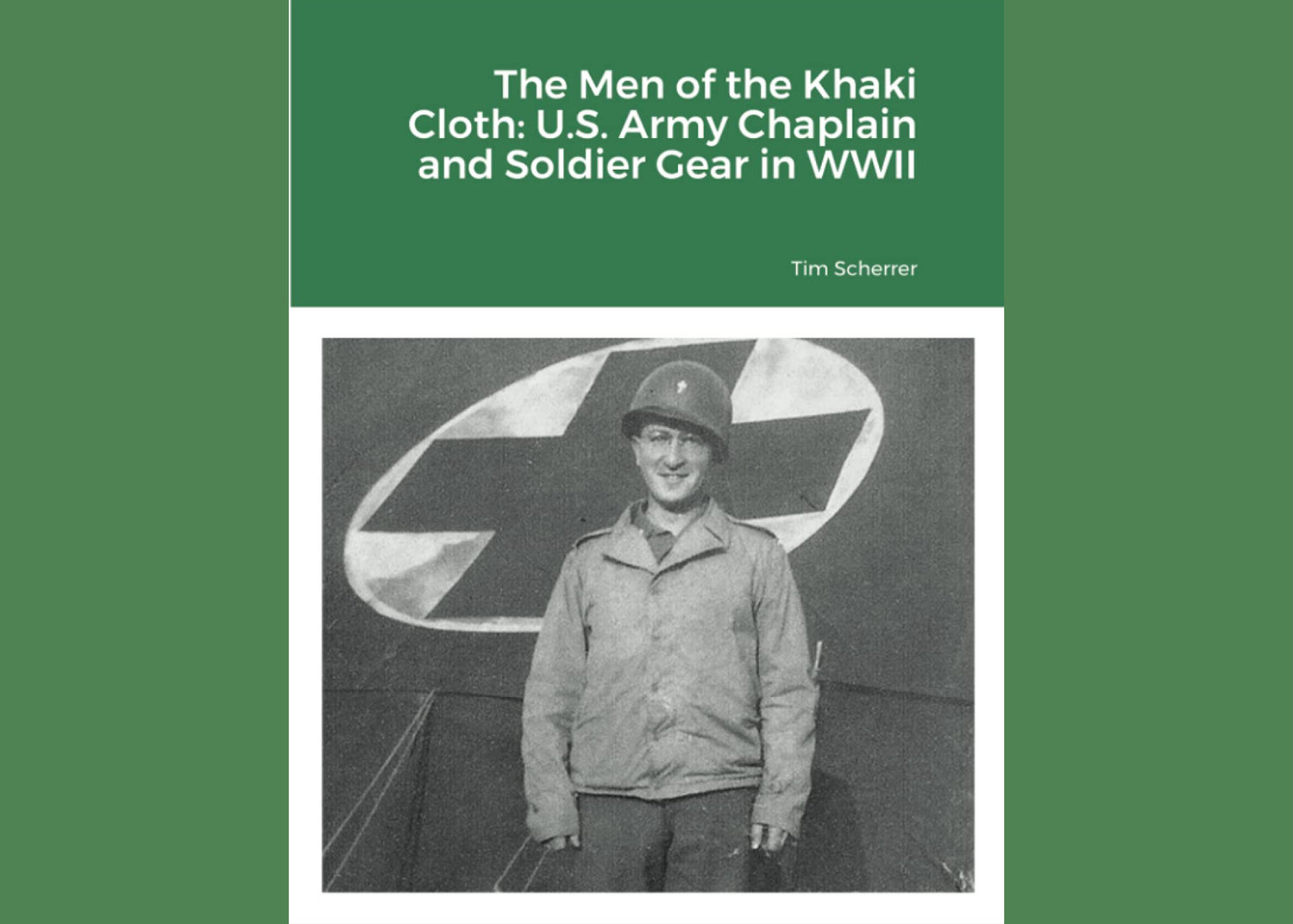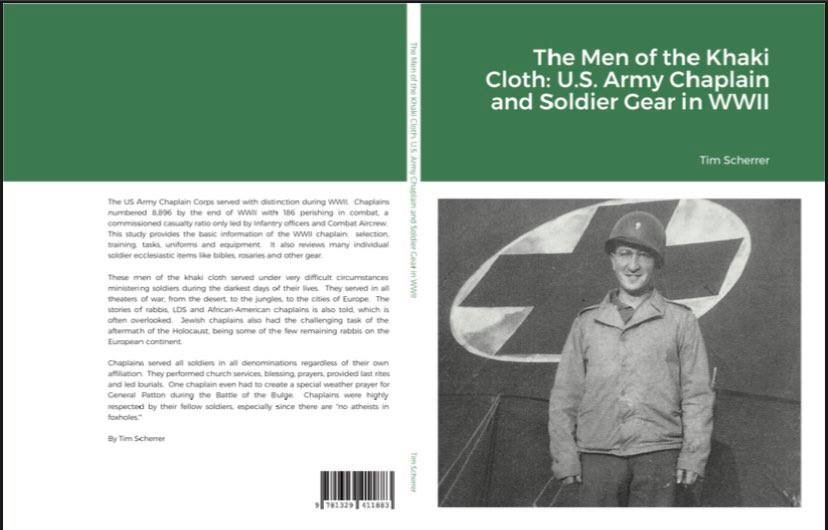Illustrated book offers glimpse into everyday life, mission of U.S. military chaplains of World War II
Author is dean of academics at Fr. Tolton Regional Catholic High School and retired Military Intelligence Officer

Military chaplains stand in the gap with their flock, interceding before commanding officers and the Supreme Commander of the Universe.
Their ministry found full expression during the largest, costliest, deadliest war in history.
“It’s absolutely God’s work,” insisted Tim Scherrer, author of The Men of the Khaki Cloth: U.S. Army Chaplain and Soldier Gear in World War II.
“You’re dealing with some of the most extreme circumstances that humans can find themselves in,” he said. “The people in those circumstances need to make sense of it.
“In many circumstances, there’s no sense to be made. You have to go to faith to understand it.”
LTC (ret.) Sherrer is Dean of Academics at Fr. Tolton Regional Catholic High School in Columbia and a retired Military Intelligence Officer, having served 28 years in the Army Reserve.
His richly illustrated offering gives basic information about World War II chaplains — how they were selected, how they were trained, what they did, what they wore and what they carried with them in ministering to the Americans on the front lines in Europe, North Africa and the South Pacific.
It also includes a chapter on items individual soldiers carried with them, including Bibles and devotional books, some with bullet-proof covers, as well as rosaries and medals.
He explains the role and responsibility of a military chaplain, the qualifications for serving in that role, and his or her place in the organizational structure.
Illustrated and illuminated inventories in the book include such standard equipment as portable desks, field altar sets, uniforms, insignia, vehicles, and wooden crates for shipping hymnals.
Such now-treasured artifacts point to practical aspects of chaplain life and shed light on day-to-day activity.
“There were so few chaplains that it was kind of easy to overlook them,” LTC (ret.) Scherrer noted. “And while you have those great stories like the Four Chaplains, there are many more stories of day-to-day guys who were doing their ministry all over the world and dealing the best they could with things they weren’t trained to deal with, and requiring significant faith to understand them.”
The author includes a few stories about heroism during the War, but mostly sticks to general information about chaplains’ responsibilities and the things they needed to carry those out.
“It’s more of a functional book on how chaplains operated versus tremendous acts of faith or heroism or serving their flocks,” LTC (ret.) Scherrer noted. “But in the end, the ‘how’ is usually interweaved with the ‘what’ with chaplains.”
Many roles
World War II drew the largest number of priests, ministers and rabbis into a military war effort in U.S. history.
Nearly 8,900 Christian ministers and a handful of Jewish rabbis were serving in the U.S. Army Chaplain Corps by the official end of hostilities in 1945.
Among those serving in World War II and later in Korea was Servant of God Father Emil Kapaun, whose recently identified remains were r laid to rest in the Cathedral of the Immaculate Conception in Wichita, Kansas.
Then as now, military chaplains walk a fine line between serving God and their country.
“They have a very specific job inside their units because they are advisors to the unit commander,” LTC (ret.) Scherrer noted. “But they’re also the spiritual leader as well as the counselor to those in their unit.”
He said the chaplain is not part of the official chain of command but nonetheless has the ear of the commander.
“The chaplain has the role of the chief morale officer of the unit and should be giving feedback to the commander about the status within the unit and what’s going on inside the unit,” the author stated.
As is the case today, most World War II chaplains undertook the same training and wore the same uniforms as fellow commissioned officers serving in their branch of the military.
Nonetheless, “most of them were and still are more concerned about their flocks than being 100-percent G.I.,” said LTC (ret.) Scherrer.
He said a military chaplain’s relationship to his unit was much like that of a chaplain to a modern-day police or fire brigade.
“Think of Father Mychal Judge, the chaplain to the New York Fire Department, who died while ministering,” he said. “He was revered among those he served.”
Cross training
LTC (ret.) Scherrer’s book sets the stage with a few human-interest stories, including the inspirational Four Chaplains, who ministered and eventually gave up their own lives during the sinking of the SS Dorchester in 1943, and a Catholic priest from Iowa who also served as a paratrooper.
That intrepid priest illustrates a chaplain’s unique position, said LTC (ret.) Scherrer.
“You have to be good at your chaplain role and also whatever military job you have,” LTC (ret.) Scherrer stated. “You have to be able to survive in those situations, except that you’re unarmed.
“Chaplains were given first-aid training,” he said, “which is generally where they ended up, around the sick and wounded when things got going hot and heavy.”
They ministered to their own and to all others when called upon.
“There’s no friend or enemy inside their ministry,” LTC (ret.) Scherrer pointed out. “There’s just people that are on their side and people who may want to hurt them.”
A rare find
LTC (ret.) Scherrer enjoys collecting, restoring and writing about historical military artifacts.
He once met a woman on an Honor Flight who later called him in search of a good home for her late father’s belongings from World War II.
As it turns out, he was a Protestant chaplain. LTC (ret.) Scherrer received a set of chaplain uniforms and a wooden case containing a Protestant field altar set.
“There were only about 9,000 of those sets made, with each chaplain receiving one based on their denomination,” he noted.
Half-kidding to friends online about this rare find, he asked if anyone knew where he could find a chaplain’s field organ from the War.
One happened to be for sale in Macon.
“So within two days, I acquired the two most difficult-to-acquire parts of the chaplain set,” said LTC (ret.) Scherrer.
He began researching World War II chaplain gear and writing a series of columns for a magazine for military collectors.
He sought insight from a then-colleague on the faculty at the Missouri Military Academy in Mexico, who had served as an Army chaplain.
“It was fun to write, fun to research, and fun to pull a lot of things together that people haven’t brought together before,” said LTC (ret.) Scherer.
About five years later, he found the columns and shared them with friends online. They suggested that he compile them into a book.
He edited and reformatted the columns into chapters during the COVID-19 pandemic and his elderly father’s convalescence.
“Pulling together the illustrations was the fun part,” he said.
Among them are photos of future president Ronald Reagan playing the role of a Catholic chaplain in a World War II training movie.
LTC (ret.) Scherrer self-published the book this year on June 6, the 77th anniversary of D-Day, when the Allied Forces’ began their land invasion of Nazi-occupied France.
Since then, he has sold about 80 copies to people in countries around the world.
Enduring legacy
For LTC (ret.) Scherrer, the most interesting part of the research was about the handful of Jewish rabbis who served in the Chaplain Corps during World War II.
“Rabbis played a very special role with the liberation of concentration camps because they were the only Jewish clergy in Central Europe at the end of WWII,” LTC (ret.) Scherrer wrote. “Most European rabbis had perished in the holocaust.”
The rabbi chaplains’ work had to be gut-wrenching.
“Most had families that migrated to the U.S. in the past 100 years, so there was extended family in Europe that made this all very personal to them,” LTC (ret.) Scherrer noted.
The book includes a photo of a rabbi conducting a worship service in what had been the home of Joseph Goebbels, a high-ranking collaborator with Hitler, after the war.
Another photo shows a rabbi leading services at the liberated Buchenwald Nazi concentration camp.
LTC (ret.) Scherrer also gives a short history of the efforts during World War II to include Church of Latter Day Saints in the Army Chaplain Corps and to secure enough chaplains from African American congregations to minister in the then-racially segregated units.
LTC (ret.) Scherrer pointed out that most World War II chaplains weren’t recognized for anything that would qualify as gallantry, “but they showed up every day. They all brought something to the table, and they were there with their unit every day. That’s what counts.”
Furthermore, the fruits of their ministry endured beyond the war’s end, helping to fuel a surge of religious fervor in the postwar United States.
Some chaplains continued serving through peacetime and into the Korean War (1950-53) and even the Vietnam War (1963-75).
The number of World War II chaplains who died or were wounded or taken prisoner in the line of duty “is a testament to their wiliness to face the same dangers as their solders, unarmed yet carrying the full armor of God,” LTC (ret.) Scherrer wrote.
The Men of the Khaki Cloth: U.S. Army Chaplain and Soldier Gear in World War II can be purchased online in hardcover and paperback editions.
Comments
Other items that may interest you
Services
The Catholic
Missourian
2207 W. Main St.
Jefferson City MO 65109-0914
(573) 635-9127
editor@diojeffcity.org







